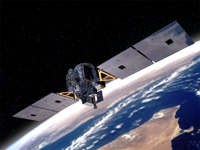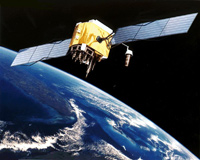Sputnik 2, launched in November 1957, carried the first living creature into orbit, a dog named Laika.
Just three months after the Soviet Unions first successful satellite launch, the USA launched its first satellite, Explorer 1, in January 1958. Since the first satellite was launched in 1957, over 6,500 satellites have been sent into orbit (as at October 2010). An estimated 3,600 of these remain in orbit. With about 1,000 still operational, the rest are now classed as space debris. The International Space Station (ISS) is the largest artificial satellite currently orbiting Earth. There's 3 main groups of satellites. Fixed satellite services handle billions of voice, data, and video transmissions. Mobile satellite systems used for navigation (GPS) and to connect remote ships, aircraft, etc. Scientific research satellites for meteorological data, land survey images, and other scientific research functions. A geostationary satellite orbits Earth from west to east over the equator. It moves in the same direction and speed as Earth is spinning, therefore from Earth, these satellites don't appear to be moving. Polar-orbiting satellites orbit Earth in a north-south direction from pole to pole, so as Earth spins underneath, these satellites scan the entire globe strip by strip. Low Earth orbit (LEO) is an altitude classification for any satellites that are in orbit less than 2000 km (1240 mi) above Earth, which has about 500 active satellites. Medium Earth orbit (MEO) is any orbit higher than LEO but still below the altitude for geostationary orbit which is 35,786 km (22,236 mi), about 50 active satellites. High Earth orbit (HEO) is any orbit higher than geostationary orbit at 35,786 km (22,236 mi), which has over 400 active satellites. 'Geocentric orbit' is the term for an orbit around Earth. 'Heliocentric orbit' is a term for an orbit of the Sun. 'Areocentric orbit' is the term for an orbit of Mars. The two main components of an artificial satellite is an antenna to send and receive information and a power source such as a solar panel or battery. The speed a satellite must travel to stay in space is called its orbital velocity. It usually needs to be more than 17,500 mph (28,200 km/h). Space debris can be anything from large obsolete satellites to natural or artificial fragments of space materials. Since 1957, the Space Surveillance Network SSN has tracked more than 26,000 objects above 10 cm in diameter. As more satellites are launched the chances of a crash increases, in 2009, two communications satellites - one American and one Russian - collided in space. Space probes have been put into orbit around other planets and moons in our solar system.
| | | 

| | More Space Facts: | | | | | | | | | | | Satellite Facts | | | | | | | | |
|